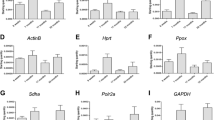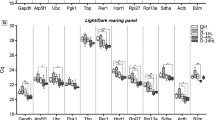Abstract
Since a growing number of studies based on the real-time reverse transcriptase polymerase chain reaction (RT-PCR) continue to be published in order to highlight genes specifically involved in brain development, maturation, and function, the identification of reference genes suitable for this kind of experiments is now an urgent need in the neuroscience field. The aim of this work was to verify the suitability of some very common housekeeping genes (such as Gapdh, 18s, and B2m) and of some relatively new control genes (such as Pgk1, Tfrc, and Gusb) during mouse brain maturation. We tested the candidate reference genes in mouse whole brain, cerebellum, brain stem, hippocampus, medial septum, frontal neocortex, and olfactory bulb. Moreover, we reported the first complete study of Pgk1 expression throughout the development and the aging of mouse brain. Although no tested gene showed to be the optimal reference for all mouse brain regions, in general, the new housekeeping genes were highly stable in most of the analyzed regions. Above all, with few exceptions, Pgk1 showed to be a reliable control for the analyzed mouse brain regions during development, maturation, and aging.






Similar content being viewed by others
References
Andersen, C. L., Jensen, J. L., & Ørntoft, T. F. (2004). Normalization of real-time quantitative reverse transcription-PCR data: A model-based variance estimation approach to identify genes suited for normalization, applied to bladder and colon cancer data sets. Cancer Research, 64, 5245–5250. doi:10.1158/0008-5472.CAN-04-0496.
Bagley, J., Larocca, G., Jimenez, D. A., & Urban, N. N. (2007). Adult neurogenesis and specific replacement of interneuron subtypes in the mouse main olfactory bulb. BMC Neuroscience, 8, 92. doi:10.1186/1471-2202-8-92.
Barroso, I., Benito, B., Garcí-Jiménez, C., Hernández, A., Obregón, M. J., & Santisteban, P. (1999). Norepinephrine, tri-iodothyronine and insulin upregulate glyceraldehyde-3-phosphate dehydrogenase mRNA during Brown adipocyte differentiation. European Journal of Endocrinology, 141, 169–179. doi:10.1530/eje.0.1410169.
Bond, B. C., Virley, D. J., Cairns, N. J., et al. (2002). The quantification of gene expression in an animal model of brain ischaemia using TaqMan real-time RT-PCR. Brain Research. Molecular Brain Research, 106, 101–116. doi:10.1016/S0169-328X(02)00417-5.
Chen, R. W., Saunders, P. A., Wei, H., Li, Z., Seth, P., & Chuang, D. M. (1999). Involvement of glyceraldehyde-3-phosphate dehydrogenase (GAPDH) and p53 in neuronal apoptosis: evidence that GAPDH is upregulated by p53. The Journal of Neuroscience, 19, 9654–9662.
Ehninger, D., & Kempermann, G. (2008). Neurogenesis in the adult hippocampus. Cell and Tissue Research, 331, 243–250. doi:10.1007/s00441-007-0478-3.
Flanagan, J. M., Rhodes, M., Wilson, M., & Beutler, E. (2006). The identification of a recurrent phosphoglycerate kinase mutation associated with chronic haemolytic anaemia and neurological dysfunction in a family from USA. British Journal of Haematology, 134, 233–237. doi:10.1111/j.1365-2141.2006.06143.x.
Goldman-Wohl, D. S., Chan, E., Baird, D., & Heintz, N. (1994). Kv3.3b: a novel Shaw type potassium channel expressed in terminally differentiated cerebellar Purkinje cells and deep cerebellar nuclei. The Journal of Neuroscience, 14, 511–522.
Goldowitz, D., & Hamre, K. (1998). The cells and molecules that make a cerebellum. Trends in Neurosciences, 21, 375–382. doi:10.1016/S0166-2236(98)01313-7.
Gutala, R. V., & Reddy, P. H. (2004). The use of real-time PCR analysis in a gene expression study of Alzheimer’s disease post-mortem brains. Journal of Neuroscience Methods, 132, 101–107. doi:10.1016/j.jneumeth.2003.09.005.
Ishitani, R., Tanaka, M., Sunaga, K., Katsube, N., & Chuang, D. M. (1998). Nuclear localization of overexpressed glyceraldehyde-3-phosphate dehydrogenase in cultured cerebellar neurons undergoing apoptosis. Molecular Pharmacology, 53, 701–707.
Johansson, S., Fuchs, A., Okvist, A., et al. (2007). Validation of endogenous controls for quantitative gene expression analysis: application on brain cortices of human chronic alcoholics. Brain Research, 1132, 20–28. doi:10.1016/j.brainres.2006.11.026.
Jones, D. T., Trowbridge, I. S., & Harris, A. L. (2006). Effects of transferrin receptor blockade on cancer cell proliferation and hypoxia-inducible factor function and their differential regulation by ascorbate. Cancer Research, 66, 2749–2756. doi:10.1158/0008-5472.CAN-05-3857.
Jung, M., Ramankulov, A., Roigas, J., et al. (2007). In search of suitable reference genes for gene expression studies of human renal cell carcinoma by real-time PCR. BMC Molecular Biology, 8, 47. doi:10.1186/1471-2199-8-47.
Livak, K. J., & Schmittgen, T. D. (2001). Methods. Analysis of relative gene expression data using real-time quantitative PCR and the 2(-Delta Delta C(T)). Method, 25, 402–408. doi:10.1006/meth.2001.1262.
Lossi, L., Tamagno, I., & Merighi, A. (2004). Molecular morphology of neuronal apoptosis: analysis of caspase 3 activation during postnatal development of mouse cerebellar cortex. Journal of Molecular Histology, 35, 621–629. doi:10.1007/s10735-004-2189-3.
Matsumoto, A., Arai, Y., Urano, A., & Hyodo, S. (1994). Androgen regulates gene expression of cytoskeletal proteins in adult rat motoneurons. Hormones and Behavior, 28, 357–366. doi:10.1006/hbeh.1994.1032.
Mescher, A. L., & Munaim, S. I. (1988). Transferrin and the growth-promoting effect of nerves. International Review of Cytology, 110, 1–26. doi:10.1016/S0074-7696(08)61846-X.
Paxinos, G., & Franklin, K. B. J. (2001). The mouse brain in stereotaxic coordinates. New York: Academic.
Perrot-Sinal, T. S., Davis, A. M., & McCarthy, M. M. (2001). Developmental sex differences in glutamic acid decarboxylase (GAD(65)) and the housekeeping gene, GAPDH. Brain Research, 922, 201–208. doi:10.1016/S0006-8993(01)03167-5.
Pohjanvirta, R., Niittynen, M., Lindén, J., Boutros, P. C., Moffat, I. D., & Okey, A. B. (2006). Evaluation of various housekeeping genes for their applicability for normalization of mRNA expression in dioxin-treated rats. Chemico-Biological Interactions, 160, 134–149. doi:10.1016/j.cbi.2006.01.001.
Proudnikov, D., Yuferov, V., LaForge, K. S., Ho, A., & Jeanne Kreek, M. (2003). Quantification of multiple mRNA levels in rat brain regions using real time optical PCR. Brain Research. Molecular Brain Research, 112, 182–185. doi:10.1016/S0169-328X(03)00056-1.
Rakic, P. (1974). Neurons in rhesus monkey visual cortex: systematic relation between time of origin and eventual disposition. Science, 183, 425–427. doi:10.1126/science.183.4123.425.
Rudy, B., & McBain, C. J. (2001). Kv3 channels: voltage-gated K+ channels designed for high-frequency repetitive firing. Trends in Neurosciences, 24, 517–526. doi:10.1016/S0166-2236(00)01892-0.
Sacco, T., De Luca, A., & Tempia, F. (2006). Properties and expression of Kv3 channels in cerebellar Purkinje cells. Molecular and Cellular Neurosciences, 33, 170–179. doi:10.1016/j.mcn.2006.07.006.
Sawa, A., Khan, A. A., Hester, L. D., & Snyder, S. H. (1997). Glyceraldehyde-3-phosphate dehydrogenase: nuclear translocation participates in neuronal and nonneuronal cell death. Proceedings of the National Academy of Sciences of the United States of America, 94, 11669–11674. doi:10.1073/pnas.94.21.11669.
Slagboom, P. E., de Leeuw, W. J., & Vijg, J. (1990). Messenger RNA levels and methylation patterns of GAPDH and beta-actin genes in rat liver, spleen and brain in relation to aging. Mechanisms of Ageing and Development, 53, 243–257. doi:10.1016/0047-6374(90)90042-E.
Sotelo-Silveira, J., Crispino, M., Puppo, A., Sotelo, J. R., & Koenig, E. (2008). Myelinated axons contain beta-actin mRNA and ZBP-1 in periaxoplasmic ribosomal plaques and depend on cyclic AMP and F-actin integrity for in vitro translation. Journal of Neurochemistry, 104, 545–557.
Svaasand, E. K., Aasly, J., Landsem, V. M., & Klungland, H. (2007). Altered expression of PGK1 in a family with phosphoglycerate kinase deficiency. Muscle & Nerve, 36, 679–684. doi:10.1002/mus.20859.
Swisshelm, K., Disteche, C. M., Thorvaldsen, J., Nelson, A., & Salk, D. (1990). Age-related increase in methylation of ribosomal genes and inactivation of chromosome-specific rRNA gene clusters in mouse. Mutation Research, 237, 131–146. doi:10.1016/0921-8734(90)90019-N.
Tanic, N., Perovic, M., Mladenovic, A., Ruzdijic, S., & Kanazir, S. (2007). Effects of aging, dietary restriction and glucocorticoid treatment on housekeeping gene expression in rat cortex and hippocampus-evaluation by real time RT-PCR. Journal of Molecular Neuroscience, 32, 38–46. doi:10.1007/s12031-007-0006-7.
Vandesompele, J., De Preter, K., Pattyn, F., et al. (2002) Accurate normalization of real-time quantitative RT-PCR data by geometric averaging of multiple internal control genes. Genome Biol. 3, RESEARCH0034.
Wong, C. C., & Leung, M. S. (2001). Effects of neonatal hypothyroidism on the expressions of growth cone proteins and axon guidance molecules related genes in the hippocampus. Molecular and Cellular Endocrinology, 184, 143–150. doi:10.1016/S0303-7207(01)00592-5.
Wood, K. A., Dipasquale, B., & Youle, R. J. (1993). In situ labeling of granule cells for apoptosis-associated DNA fragmentation reveals different mechanisms of cell loss in developing cerebellum. Neuron, 11, 621–632. doi:10.1016/0896-6273(93)90074-2.
Yang, M. H., Yoo, K. H., Yook, Y. J., et al. (2007). The gene expression profiling in murine cortical cells undergoing programmed cell death (PCD) induced by serum deprivation. Journal of Biochemistry and Molecular Biology, 40, 277–285.
Zhang, H. L., Eom, T., Oleynikov, Y., et al. (2001). Neurotrophin-induced transport of a beta-actin mRNP complex increases beta-actin levels and stimulates growth cone motility. Neuron, 31, 261–275. doi:10.1016/S0896-6273(01)00357-9.
Acknowledgements
The experiments were supported by grants (to FT) from: MIUR (PRIN-2005), Regione Piemonte (Ricerca Scientifica Applicata 2004 projects A183 and A74 and Ricerca Sanitaria Finalizzata 2006 and 2007), Compagnia di San Paolo, Fondazione CRT (Progetto Alfieri). EB is recipient of a CRT fellowship (Progetto Lagrange). The authors gratefully thank Annarita De Luca for the helpful suggestions and Matteo Novello for the technical support.
Author information
Authors and Affiliations
Corresponding author
Rights and permissions
About this article
Cite this article
Boda, E., Pini, A., Hoxha, E. et al. Selection of Reference Genes for Quantitative Real-time RT-PCR Studies in Mouse Brain. J Mol Neurosci 37, 238–253 (2009). https://doi.org/10.1007/s12031-008-9128-9
Received:
Accepted:
Published:
Issue Date:
DOI: https://doi.org/10.1007/s12031-008-9128-9




